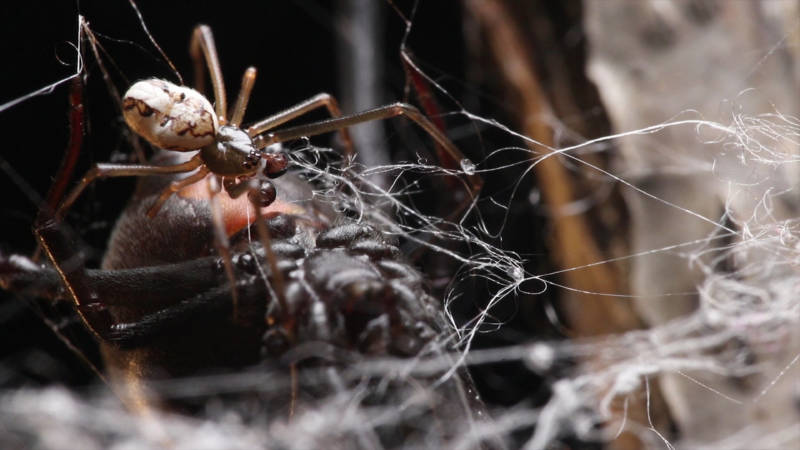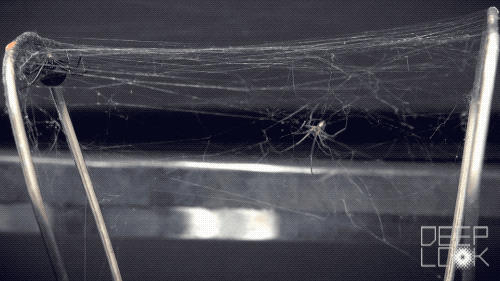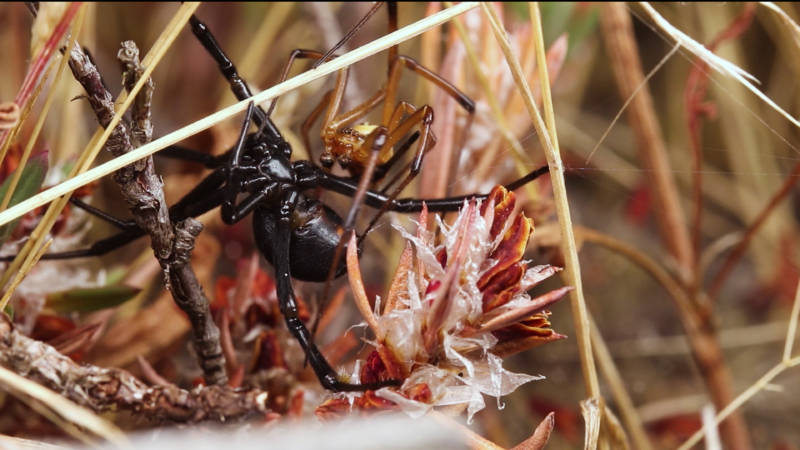Why the Male Black Widow Spider Is a Real Home Wrecker
These are the longest nights of the year, which is good news for nocturnal animals like the black widow spider, which prefers to slink around in the darkness, hiding in obscure places like inside pipes and under porches.
“Black widows start coming out around twilight when it’s not completely dark,” said Rick Vetter, a retired scientist at UC Riverside who has studied the spider for 40 years. That’s when they start to build their tangled webs, he said, which they’ll live in their whole lives.

We’ve all heard the stories. She mates and then kills. Her venom is 15 times stronger than a rattlesnake’s. One bite could kill you. With a shiny black color and a glaring red hourglass stomach, she has long inspired fear and awe.
But it turns out, scientists say, much of that is overblown.
“I think the black widow’s reputation is totally undeserved,” said Catherine Scott, an arachnologist at the University of Toronto who has researched black widows for years.
Most species of widow spider (there are 31), including the western black widow found in the U.S., don’t kill their mates at all. Only two widow spider species always eat their mate — the Australian redback and the brown widow, an invasive species in California.
And the male seems to be asking for it. In both of these species, he offers himself to her, somersaulting into her mouth after copulation.

If the western black widow does eat the male, Scott said, it’s because she mistakes him for food.
“If the male enters the female’s web and she’s really hungry, she might be more interested in her next meal than mating,” Scott said.
How he approaches her could mean the difference between life and death. When advancing on a female in her web, a male black widow must create the right vibrations with his abdomen that tell her, “I’m here to mate, not be food.”
Scott is conducting a research project to illuminate the antics of the male black widow, the neglected character in the mating drama. It turns out the males are far from innocent bystanders, according to Scott.
“Male black widows have their own web,” said Scott, “but after their final molt, they abandon it and search for females.”
During peak mating season, thousands of males will prowl around looking for females. Females set up their webs, stay put and wait.
Female black widows use pheromone-laced silk to attract males. “Kind of like a chemical personal ad,” Scott said.
The male can detect this scent from 200 feet away, a long distance when you’re the size of a grain of rice. The scent tells the whole story of her mating history and even includes her hunger level.

Once the male arrives at her silken abode, he starts to wreck it, systematically disassembling her web one strand at a time. In a process scientists call web reduction, he bunches it into a little ball and wraps it up with his own silk. Scott suspects that he’s doing this to reduce competition from other males — masking her come-hither scent with this own smell that says “Keep Out.”
The strange thing is that female black widows seem to like it. In her research, Scott has found that females are less aggressive and become receptive to mating sooner when males tear down their webs.
By taking down their silk, male black widows may even be doing females a favor, Scott said.
As long as her pheromone-laden silk is around her, she will continue attracting males, as much as 40 each night, even if she’s done mating.
“As soon as she’s mated, she wants to get on with eating more, spinning her egg sacs and producing offspring,” Scott said. “She doesn’t need any more males around, and it might actually be more of a nuisance to be constantly harassed.”
By tearing down her silk and masking the scent, the male is giving her the opportunity to rebuild her web with some new neutral silk. It’s like he’s helping her remodel.

Scott suspects that there are some chemicals in the male’s silk that are attractive to females. While mating, he will wrap her in fine strands that researchers refer to as the bridal veil. He drapes his silk over her legs, where her smell receptors are most concentrated.
After all that, he is most likely to crawl away, alive and unscathed.
What about that deadly bite, supposedly so fatal to humans? While many people report black widow spider bites every year, only a fraction result in serious symptoms, and almost none result in death.
Biting is the widow’s last defensive recourse, like if she’s about to be squished by a looming human foot.
In his work, Vetter pioneered research into the female black widow’s defensive behavior, illuminating how, when confronted, she will stretch a special type of silk between her two back legs and brandish it at an attacker.
“The silk looks like fishing line covered in droplets of glue,” said Vetter. This silk is extremely unpleasant to the curious — it can get stuck to their nose. As the tangled predator tries to free itself, the widow has a chance to run.
“They are not aggressive at all,” he said. “Their first response when you destroy their web, usually, is to run into their retreat and hide, or to drop off their web and curl up into a little ball on the ground and play dead. Those aren’t exactly scary aggressive tactics.”
Scott said the biggest misconception about black widows is that they’re something to fear.
“They’re really shy spiders,” she said. “They just want to be left alone.”